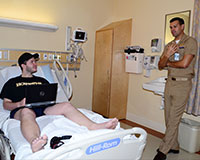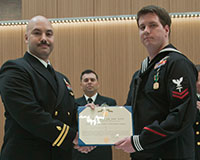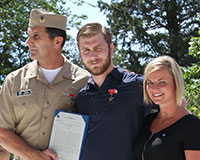Sailors and Coast Guardsmen may self-refer to the program or be referred by family members, command leadership or medical providers.
Disability Evaluation System
After a serious injury or illness, a wounded warrior’s fitness for duty may need to be assessed to determine if they are capable of continuing to perform military duties. The process of evaluating a Service Member’s fitness for duty is conducted through the Disability Evaluation System (DES). For USN members there are two options including the Integrated Disability Evaluation System (IDES) or the Legacy Disability Evaluation System (LDES). The default for a USN member is the IDES. This is collaboration between the Department of Defense (DoD) and VA resulting in both DoD and VA disability rating determinations. The LDES primarily applies to initial entry members (less than 180 days Active Duty and Mid-Shipman). It is also an option for all for all other USN members with Commanding Officer (CO) approval during the initial DES referral process. For USCG members only the LDES is available, and is referred to as the DES in the Coast Guard.
The IDES includes both the DoD and VA medical evaluations. DoD evaluates the medical and physical condition of wounded warriors to determine fitness for military duty. The VA evaluates and rates the extent of disabilities, if wounded warriors are found unfit, and determines the level of compensation they are entitled to receive.
The disability evaluation process can sometimes be confusing – and often time-consuming – for service members grappling with a serious illness or injury. However, the process has long-reaching implications, and its outcome is extremely important to wounded warriors and their families.
Initial Treatment
When a Sailor or Coast Guardsman becomes wounded, ill or injured, an attending physician at the medical treatment facility will assess and treat them.
The wounded warrior is then assigned a medically-restricted status:
- Sick-in-Quarters
- Light Duty
- Temporary Limited Duty
- Medical Hold (for Navy Reserve members)
Referral to DES
If a wound, illness or injury results in a permanent condition or has long-lasting effects, the wounded warrior is referred to the DES by an attending physician. Once referred to the DES, the wounded warrior is assigned a Physical Evaluation Board Liaison Officer (PEBLO), who counsels them on the DES process and organizes examinations and assessments of their medical condition.
The wounded warrior’s attending physician writes a summary of the medical examinations (NARSUM) and compiles a Medical Evaluation Board Report (MEBR) on the wounded warrior’s condition. The PEBLO submits the MEBR to the Medical Evaluation Board (MEB).
MEB Phase
An MEB reviews and evaluates a wounded warrior’s MEBR to determine if they can perform their job in the Navy or Coast Guard, or if they will be able to perform their particular duties within one full year.
When an MEB decides a wounded warrior is or will be able to perform their particular duties, they are returned to full duty in their current job. When an MEB decides a wounded warrior does not meet the medical retention standards necessary to perform their duties, they are referred to a Physical Evaluation Board (PEB). Wounded warriors have the right to appeal an MEB’s decision.
PEB Phase
Informal
A PEB meets informally to review a wounded warrior’s MEBR and their level of disability to determine if they are fit to remain in the Navy or Coast Guard.
When a PEB determines a wounded warrior is fit for duty, they may return to duty, but perhaps in a modified role or capacity.
When a PEB decides a wounded warrior is unfit for duty, they may be separated from service or given retirement status, depending on the severity of the illness or injury.
The PEBLO notifies the wounded warrior of informal PEB findings.
Unfit wounded warriors are referred to VA for disability ratings that will determine their level of disability compensation.
Formal
If an appeal to the formal PEB is granted, a wounded warrior is allowed to appear before the PEB to discuss the case with board members and to ask them to reconsider the decision.
Wounded warriors have the right to be represented by legal counsel at formal PEBs. PEBLOs and Navy Wounded Warrior can provide wounded warriors with information about accessing legal counsel.
The PEBLO notifies wounded warriors of formal PEB findings.
Transition Phase
When a PEB issues its final decision (disposition) on a wounded warrior’s case, there are five possible outcomes:
- Return to duty
- Separate without benefits
- Separate with severance pay
- Transfer to the temporary disability retirement list
- Transfer to the permanent disability retirement list
Wounded warriors found fit for duty are returned to service. Wounded warriors found unfit for duty are processed for separation or retirement.
Numquam Navigare Solus – Never to Sail Alone
Sailors and Coast Guardsmen may self-refer to Navy Wounded Warrior, or be referred by a family member, their command leadership or their medical team. Contact the Navy Wounded Warrior call center at 855-NAVY WWP / 855-628-9997, or email navywoundedwarrior.fct@navy.mil.


 Enrollment
Enrollment
 Recovery
Recovery
 Transition
Transition
 Families
Families
 Leadership
Leadership



